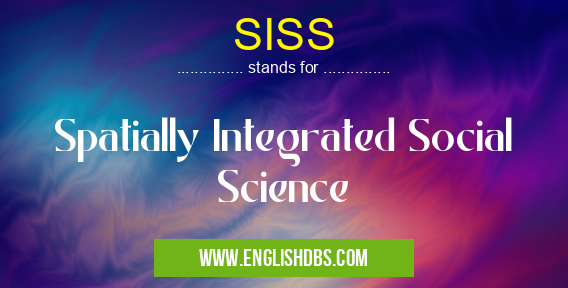What does SISS mean in ACADEMIC & SCIENCE
SISS stands for Spatially Integrated Social Science. It is an interdisciplinary field that combines spatial analysis with social science research to gain a more comprehensive understanding of human behavior and social phenomena.

SISS meaning in Academic & Science in Academic & Science
SISS mostly used in an acronym Academic & Science in Category Academic & Science that means Spatially Integrated Social Science
Shorthand: SISS,
Full Form: Spatially Integrated Social Science
For more information of "Spatially Integrated Social Science", see the section below.
Meaning in Science
SISS integrates theories and methods from geography, sociology, economics, and other social sciences to examine how spatial factors influence social outcomes. By analyzing data related to location, space, and time, SISS researchers can identify patterns and relationships that are not readily apparent through traditional social science approaches.
Full Form
- S: Spatial
- I: Integrated
- S: Social
- S: Science
What does SISS Stand for?
SISS stands for the integration of spatial analysis and social science research, with a focus on understanding:
- Spatial patterns: The distribution of people, resources, and activities across space.
- Spatial processes: The mechanisms that create and change spatial patterns.
- Social processes: The ways in which social interactions shape and are shaped by spatial factors.
Essential Questions and Answers on Spatially Integrated Social Science in "SCIENCE»SCIENCE"
What is Spatially Integrated Social Science (SISS)?
SISS is an interdisciplinary approach that integrates spatial analysis with social science methods to examine the spatial patterns and relationships of social phenomena. It combines theories and techniques from geography, sociology, economics, and other social sciences to understand how spatial factors influence human behavior and social outcomes.
What are the key elements of SISS?
SISS involves:
- Spatial analysis: Using geographic information systems (GIS) and statistical techniques to analyze spatial data and identify patterns and relationships.
- Social science methods: Employing qualitative and quantitative research methods from social sciences to collect and analyze social data.
- Interdisciplinary collaboration: Bringing together researchers from different disciplines to explore complex social issues from a comprehensive perspective.
What are the applications of SISS?
SISS is used in various fields, including:
- Urban planning and development
- Crime analysis and prevention
- Environmental sustainability
- Health geography
- Transportation and infrastructure planning
- Social justice and equity
What are the benefits of using SISS? A: SISS provides several benefits: Improved understanding of social phenomen
SISS provides several benefits:
- Improved understanding of social phenomena: By incorporating spatial analysis, SISS enhances our understanding of how spatial factors shape social outcomes.
- Enhanced decision-making: SISS provides spatial insights that can inform policy decisions and improve planning and management.
- Interdisciplinary collaboration: SISS fosters collaboration among researchers from different disciplines, leading to innovative and comprehensive solutions.
How can I learn more about SISS?
To learn more about SISS:
- Academic programs: Universities and research institutions offer specialized programs in SISS.
- Research publications: Scholarly journals and conferences publish research findings in the field of SISS.
- Professional organizations: Organizations such as the Regional Science Association International promote SISS research and education.
Final Words: SISS is a powerful tool for advancing our understanding of the complex relationship between space and society. By bridging the gap between spatial analysis and social science research, SISS provides researchers with a more holistic approach to investigating social phenomena and developing evidence-based solutions to societal challenges.
SISS also stands for: |
|
| All stands for SISS |
